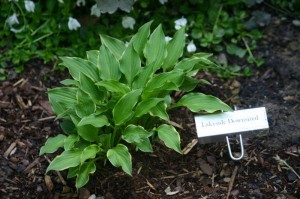 Creating unity in your garden with clusters of the same plants spread throughout the yard is a common way to design garden spaces. While groupings of the same species can create a nice relaxing repetition, rhythm and simplicity in your garden, mixed plants in groupings can add more visual energy to your garden. The combinations of colors and textures stimulate your eyes and lift your plants off the garden floor. With all the multiplying varieties, it helps to create nameplates for plants in your garden.
Creating unity in your garden with clusters of the same plants spread throughout the yard is a common way to design garden spaces. While groupings of the same species can create a nice relaxing repetition, rhythm and simplicity in your garden, mixed plants in groupings can add more visual energy to your garden. The combinations of colors and textures stimulate your eyes and lift your plants off the garden floor. With all the multiplying varieties, it helps to create nameplates for plants in your garden.
Diverse plantings allow a small space to retain constant blooms or color. Some people choose to cluster plants because of their varied colors, shapes or sizes. But those plants can also have varied blooming times which allow your clusters to always look fresh and active. Even hostas send up tall stems of purple or white blooms and don’t have to rely on their beautiful leaves alone. By adding in a mix of early and late spring, summer and fall bloomers, your plant clusters will always be colorful.
Nameplates among these clusters can help you anticipate which plants will bloom next as the year progresses. When you create nameplates for plants you not only inform your visitors, but you set the stage for what action is to come.
Combining plants in clusters allows you to easily replace a plant that dies or that just doesn’t suit your interest anymore. If a large planting of the same plant were to succumb to disease or insects, it may leave a noticeable open area or hole in your garden until you could figure out what to plant there next. You may hastily choose a plant just to fill the ugly space or may be anxious while you wait to figure out something new. If one plant dies within a cluster of plants, there is no hurry to replace it as the surrounding plants fill in the spaces that were left behind.
Creating clusters of diverse plants doesn’t have to mean disorder in your yard. If you like a little order and a little chaos in your garden—if you’re one of those diversified people—then you can arrange clusters of diversified plants in repetitive flowerbeds throughout your garden. Ferns, coral bells and lime-green hostas can create a lovely ground bouquet in your yard. That same combination can be spread throughout your garden to set a repetition of diversity.
When you create nameplates for plants you are also creating some order in your diverse garden. Shiny stainless steel posts can pose through the blossoms and leaves of your garden floor and reveal the names to your lively disarray of stems, seeds and petals. Kincaid Plant Markers can provide you with nameplates so that you can find your favorites, watch for the next burst of color and share your gardening passion with family and friends.
